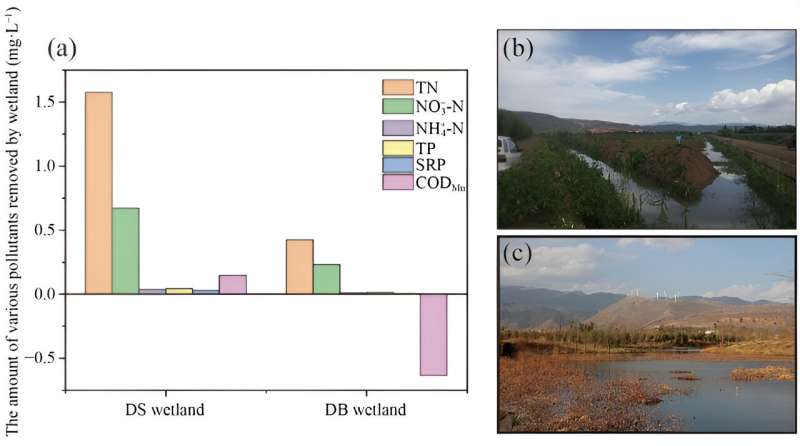This article has been reviewed according to Science X's editorial process and policies. Editors have highlighted the following attributes while ensuring the content's credibility:
fact-checked
proofread
Will long-term operation of constructed wetlands become a source of pollution itself?

Eutrophication of lakes is a global environmental issue, and polluted inflowing rivers are important external factors leading to lake eutrophication.
Prior to 2018, the Yong'an River, an inflowing river into Erhai Lake in Dali Bai Autonomous Prefecture, Yunnan Province, suffered from agricultural non-point source pollution caused by the rapid expansion of industries such as garlic cultivation and dairy farming within its watershed.
Excessive pollutants contained in fertilizers and livestock manure would flow into the Yong'an River with water runoff and subsequently enter Erhai Lake, exacerbating its eutrophication and triggering a series of ecological environmental problems.
The Yong'an River basin is rich in natural wetland resources; however, due to lack of human intervention and management, the capacity for pollutant retention and purification in natural wetlands is limited.
Constructed wetlands, which are constructed in parallel to rivers, have been proven as an effective measure for reducing pollution from inflowing rivers into lakes. However, whether long-term operation of constructed wetlands can still effectively remove pollutants remains a topic of ongoing debate because if not properly managed, large plants that grow in wetlands over time can clog their pores and reduce pollutant removal efficiency.
Additionally, decaying plant residues and detached biofilms can become organic sources of pollution themselves if not promptly cleaned.
Researcher Wang Xinze and his team from Shanghai Jiao Tong University have been dedicated to the protection and pollution control of plateau lakes, relying on the National Observation and Research Station of Erhai Lake Ecosystem in Yunnan Dali and the Yunnan Dali Research Institute of Shanghai Jiao Tong University.
The team directly participated in the construction of constructed wetlands in the upstream of Yong'an River in Erhai Lake, and conducted continuous water quality monitoring for nine years on two parallel constructed wetlands (Dashuying Wetland and Dengbeiqiao Wetland) connected to Yong'an River, in order to assess whether these long-term operating artificial wetlands can still purify polluted rivers.
The research results, published in the journal Frontiers of Agricultural Science and Engineering, indicate that the main pollutants in the Yong'an River are total nitrogen and nitrate nitrogen, which mainly come from the input of nitrogen-containing pollutants from fertilizers and livestock manure in the basin.
During its nine-year operation, constructed wetlands have maintained a high removal efficiency for nitrogen and phosphorus, thanks to the absorption and utilization of plants and microorganisms in wetlands. However, low temperatures in winter can cause plant decay and reduce microbial activity, thereby lowering denitrification and phosphorus removal efficiency.
On the other hand, constructed wetlands have poor ability to remove organic pollutants and even become potential sources of organic pollution.
The removal of organic pollutants by constructed wetlands is mainly achieved through interception, adsorption, etc., which cannot be directly utilized by plants or microorganisms like inorganic pollutants. In addition, if large plants and biofilms inside wetlands are not cleaned up promptly, they will not only block pores within the substrate but also become part of organic pollution.
Therefore, it is necessary to improve management capabilities during actual operation of constructed wetlands so as to timely clear residual materials within them; this will enable parallel-connected artificial wetlands with rivers to truly play their role in removing pollutants.
More information: Huaji LIU et al, Reduction of non-point source pollution in the Yong'an River by constructed wetland based on 9 years of monitoring, Frontiers of Agricultural Science and Engineering (2023). DOI: 10.15302/J-FASE-2023516
Provided by Frontiers Journals



















